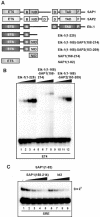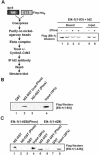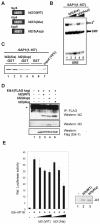Regulation of TCF ETS-domain transcription factors by helix-loop-helix motifs
- PMID: 12907712
- PMCID: PMC169972
- DOI: 10.1093/nar/gkg689
Regulation of TCF ETS-domain transcription factors by helix-loop-helix motifs
Abstract
DNA binding by the ternary complex factor (TCF) subfamily of ETS-domain transcription factors is tightly regulated by intramolecular and intermolecular interactions. The helix-loop-helix (HLH)-containing Id proteins are trans-acting negative regulators of DNA binding by the TCFs. In the TCF, SAP-2/Net/ERP, intramolecular inhibition of DNA binding is promoted by the cis-acting NID region that also contains an HLH-like motif. The NID also acts as a transcriptional repression domain. Here, we have studied the role of HLH motifs in regulating DNA binding and transcription by the TCF protein SAP-1 and how Cdk-mediated phosphorylation affects the inhibitory activity of the Id proteins towards the TCFs. We demonstrate that the NID region of SAP-1 is an autoinhibitory motif that acts to inhibit DNA binding and also functions as a transcription repression domain. This region can be functionally replaced by fusion of Id proteins to SAP-1, whereby the Id moiety then acts to repress DNA binding in cis. Phosphorylation of the Ids by cyclin-Cdk complexes results in reduction in protein-protein interactions between the Ids and TCFs and relief of their DNA-binding inhibitory activity. In revealing distinct mechanisms through which HLH motifs modulate the activity of TCFs, our results therefore provide further insight into the role of HLH motifs in regulating TCF function and how the inhibitory properties of the trans-acting Id HLH proteins are themselves regulated by phosphorylation.
Figures







Similar articles
-
Net (ERP/SAP2) one of the Ras-inducible TCFs, has a novel inhibitory domain with resemblance to the helix-loop-helix motif.EMBO J. 1996 Nov 1;15(21):5849-65. EMBO J. 1996. PMID: 8918463 Free PMC article.
-
Id helix-loop-helix proteins inhibit nucleoprotein complex formation by the TCF ETS-domain transcription factors.EMBO J. 1999 Feb 15;18(4):968-76. doi: 10.1093/emboj/18.4.968. EMBO J. 1999. PMID: 10022839 Free PMC article.
-
Comparative analysis of the ternary complex factors Elk-1, SAP-1a and SAP-2 (ERP/NET).EMBO J. 1995 Jun 1;14(11):2589-601. doi: 10.1002/j.1460-2075.1995.tb07257.x. EMBO J. 1995. PMID: 7540136 Free PMC article.
-
Ternary complex factors: growth factor regulated transcriptional activators.Curr Opin Genet Dev. 1994 Feb;4(1):96-101. doi: 10.1016/0959-437x(94)90097-3. Curr Opin Genet Dev. 1994. PMID: 8193547 Review.
-
Helix-loop-helix proteins in mammary gland development and breast cancer.J Mammary Gland Biol Neoplasia. 2003 Apr;8(2):225-39. doi: 10.1023/a:1025957025773. J Mammary Gland Biol Neoplasia. 2003. PMID: 14635797 Review.
Cited by
-
Aryl hydrocarbon receptor promotes RORγt⁺ group 3 ILCs and controls intestinal immunity and inflammation.Semin Immunopathol. 2013 Nov;35(6):657-70. doi: 10.1007/s00281-013-0393-5. Epub 2013 Aug 23. Semin Immunopathol. 2013. PMID: 23975386 Free PMC article. Review.
-
SIRT7, H3K18ac, and ELK4 Immunohistochemical Expression in Hepatocellular Carcinoma.J Pathol Transl Med. 2016 Sep;50(5):337-44. doi: 10.4132/jptm.2016.05.20. Epub 2016 Aug 5. J Pathol Transl Med. 2016. PMID: 27498548 Free PMC article.
-
Extrinsic and intrinsic regulation of early natural killer cell development.Immunol Res. 2008;40(3):193-207. doi: 10.1007/s12026-007-8006-9. Immunol Res. 2008. PMID: 18266115 Review.
-
Mature natural killer cell and lymphoid tissue-inducing cell development requires Id2-mediated suppression of E protein activity.J Exp Med. 2007 May 14;204(5):1119-30. doi: 10.1084/jem.20061959. Epub 2007 Apr 23. J Exp Med. 2007. PMID: 17452521 Free PMC article.
-
Coinfection of novel goose parvovirus-associated virus and duck circovirus in feather sacs of Cherry Valley ducks with feather shedding syndrome.Poult Sci. 2020 Sep;99(9):4227-4234. doi: 10.1016/j.psj.2020.05.013. Epub 2020 Jun 17. Poult Sci. 2020. PMID: 32867966 Free PMC article.
References
-
- Treisman R. (1994) Ternary complex factors: growth regulated transcriptional activators. Curr. Opin. Genet. Dev., 4, 96–101. - PubMed
-
- Sharrocks A.D. (2002) Complexities in ETS-domain transcription factor function and regulation; lessons from the TCF subfamily. Biochem. Soc. Trans., 30, 1–9. - PubMed
-
- Gille H., Sharrocks,A.D. and Shaw,P.E. (1992) Phosphorylation of transcription factor p62TCF by MAP kinase stimulates ternary complex formation at c-fos promoter. Nature, 358, 414–417. - PubMed
-
- Sharrocks A.D. (1995) ERK2/p42 MAP kinase stimulates both autonomous and SRF-dependent DNA binding by Elk-1. FEBS Lett., 368, 77–80. - PubMed
Publication types
MeSH terms
Substances
Grants and funding
LinkOut - more resources
Full Text Sources
Miscellaneous

